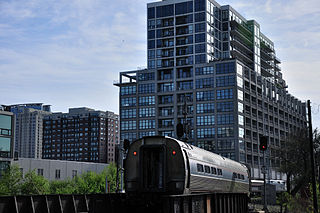
The Burlington Northern Railroad was a United States-based railroad company formed from a merger of four major U.S. railroads. Burlington Northern operated between 1970 and 1996.

The Northern Pacific Railway was a transcontinental railroad that operated across the northern tier of the western United States, from Minnesota to the Pacific Northwest. It was approved by Congress in 1864 and given nearly forty million acres of land grants, which it used to raise money in Europe for construction.

Ralph Budd was an American railroad executive.

William Barstow Strong served as president of the Atchison, Topeka and Santa Fe Railway from 1881 to 1889. He is often referred to as either William B. Strong or W. B. Strong.

The Bloomer Shippers Connecting Railroad, headquartered in Gibson City, Illinois, is a Class III railroad serving agricultural communities in east-central Illinois.

The St. Charles Air Line is a rail line in Chicago, Illinois, partially owned by the BNSF Railway, Union Pacific Railroad, and Canadian National Railway.

The Illinois and Midland Railroad is a railroad in the U.S. state of Illinois, serving Peoria, Springfield and Taylorville. Until 1996, when Genesee & Wyoming Inc. bought it, the company was named the Chicago and Illinois Midland Railway. It was once a Class I railroad, specializing in the hauling of coal. At the end of 1970 it operated 121 route-miles on 214 miles of track; it reported 255 million ton-miles of revenue freight that year.

The Pittsburgh, Cincinnati, Chicago and St. Louis Railroad, commonly called the Pan Handle Route, was a railroad that was part of the Pennsylvania Railroad system. Its common name came from its main line, which began at Pittsburgh, Pennsylvania, crossed the Northern Panhandle of West Virginia, and continued west to Bradford, Ohio, where it split into a northern line to Chicago and a southern one through Indianapolis, Indiana, to East St. Louis, Illinois.

The Alton Railroad was the final name of a railroad linking Chicago to Alton, Illinois, St. Louis, Missouri, and Kansas City, Missouri. Its predecessor, the Chicago and Alton Railroad, was purchased by the Baltimore and Ohio Railroad in 1931 and was controlled until 1942 when the Alton was released to the courts. On May 31, 1947 the Alton Railroad was merged into the Gulf, Mobile and Ohio Railroad. Jacob Bunn had been one of the founding reorganizers of the Chicago & Alton Railroad Company during the 1860s.

The Chicago Railroad Fair was an event organized to celebrate and commemorate 100 years of railroad history west of Chicago, Illinois. It was held in Chicago in 1948 and 1949 along the shore of Lake Michigan and is often referred to as "the last great railroad fair" with 39 railroad companies participating. The board of directors for the show was a veritable "Who's Who" of railroad company executives.

The Hannibal and St. Joseph Railroad was the first railroad to cross Missouri starting in Hannibal in the northeast and going to St. Joseph, Missouri, in the northwest. It is said to have carried the first letter to the Pony Express on April 3, 1860, from a train pulled behind the locomotive Missouri.
The following is a brief history of the North American rail system, mainly through major changes to Class I railroads, the largest class by operating revenue.
The following is a brief history of the North American rail system, mainly through major changes to Class I railroads, the largest class by operating revenue.
The Chicago and Aurora Railroad was an early predecessor of the Chicago, Burlington and Quincy Railroad that built a line from West Chicago to Mendota via Aurora, Illinois.

Gilchrist is an unincorporated community in Greene Township, Mercer County, Illinois, United States. Gilchrist is 2 miles (3.2 km) west of Viola.

The Wabash Railroad was a Class I railroad that operated in the mid-central United States. It served a large area, including track in the states of Ohio, Indiana, Illinois, Iowa, Michigan, and Missouri and the province of Ontario. Its primary connections included Chicago, Illinois; Kansas City, Missouri; Detroit, Michigan; Buffalo, New York; St. Louis, Missouri; and Toledo, Ohio.
The Mississippi Valley and Western Railway (MV&W) was the name of three different shortline railroads which operated in the U.S. states of Iowa and Missouri. The first company was formed on January 25, 1871, and existed for just five days before merging with a much larger road. On January 20, 1873, two other railroads merged with the MV&W to create a second consolidated company. This last railroad went bankrupt on August 7, 1874, having constructed only a minimal amount of track. The bankrupt firm was sold to the St. Louis, Keokuk and North Western Railway.















